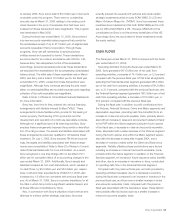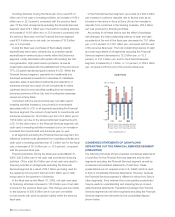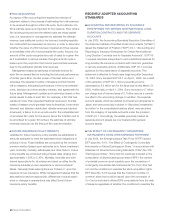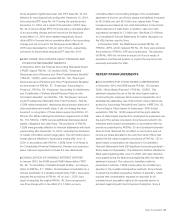Sony 2005 Annual Report Download - page 66
Download and view the complete annual report
Please find page 66 of the 2005 Sony annual report below. You can navigate through the pages in the report by either clicking on the pages listed below, or by using the keyword search tool below to find specific information within the annual report.Sony Corporation 63
■INVESTMENTS
Sony’s investments are comprised of debt and equity securities
accounted for under both the cost and equity method of
accounting. If it has been determined that an investment has
sustained an other-than-temporary decline in its value, the
investment is written down to its fair value by a charge to
earnings. Sony regularly evaluates its investment portfolio to
identify other-than-temporary impairments of individual securi-
ties. Factors that are considered by Sony in determining whether
an other-than-temporary decline in value has occurred include:
the length of time and extent to which the market value of the
security has been less than its original cost, the financial
condition, operating results, business plans and estimated future
cash flows of the issuer of the security, other specific factors
affecting the market value, deterioration of credit condition of the
issuers, sovereign risk, and ability to retain the investment for a
period of time sufficient to allow for the anticipated recovery in
market value.
In evaluating the factors for available-for-sale securities whose
fair values are readily determinable, management presumes a
decline in value to be other-than-temporary if the fair value of the
security is 20 percent or more below its original cost for an
extended period of time (generally a period of up to six to twelve
months). This criteria is employed as a threshold to identify
securities which may have a decline in value that is other-than-
temporary. The presumption of an other-than-temporary
impairment in such cases may be overcome if there is evidence
to support that the decline is temporary in nature due to the
existence of other factors which overcome the duration or
magnitude of the decline. On the other hand, there may be
cases where impairment losses are recognized when the decline
in the fair value of the security is not more than 20% or such
decline has not existed for an extended period of time, as a
result of considering specific factors which may indicate the
decline in the fair value is other-than-temporary.
The assessment of whether a decline in the value of an
investment is other-than-temporary often requires management
judgment based on evaluation of relevant factors. Those factors
include business plans and future cash flows of the issuer of the
security, the regulatory, economic or technological environment
of the investee, and the general market condition of either the
geographic area or the industry in which the investee operates.
Accordingly, it is possible that investments in Sony’s portfolio
that have had a decline in value that are currently believed to
be temporary may determine to be other-than-temporary in the
future based on Sony’s evaluation of additional information such
as continued poor operating results, future broad declines in
value of worldwide equity markets or circumstances in market
interest rate fluctuations. As a result, unrealized losses
recorded for investments may be recognized into income
in future periods.
■IMPAIRMENT OF LONG-LIVED ASSETS
Sony reviews the carrying value of its long-lived assets held and
used and long-lived assets to be disposed of whenever events
or changes in circumstances indicate that the carrying value of
the assets may not be recoverable. This review is performed
using estimates of future cash flows by product category (e.g.
TV display CRTs) or entity (e.g. semiconductor manufacturing
division in the U.S.). If the carrying value of the asset is consid-
ered impaired, an impairment charge is recorded for the amount
by which the carrying value of the asset exceeds its fair value.
Fair value is determined using the present value of estimated net
cash flows or comparable market values.
Management believes that the estimates of future cash flows
and fair value are reasonable; however, changes in estimates
resulting in lower future cash flows and fair value due to unfore-
seen changes in business assumptions could negatively affect
the valuations of those long-lived assets. These unforeseen
changes include a possible further decline in demand for TV
display CRTs due to a shift in demand from CRT displays to
LCD and plasma panel displays.
In the fiscal year ended March 31, 2003, Sony recorded
impairment charges for long-lived assets totaling 12.4 billion
yen. This included 8.1 billion yen for the impairment of semicon-
ductor and computer display CRT manufacturing equipment to
be abandoned or to be sold in connection with certain restruc-
turing activities in the Electronics segment. It also included 2.7
billion yen for the impairment of a CD manufacturing facility in
the U.S., the fair value of which was estimated by using meth-
ods such as a survey of the local real estate market.
In the fiscal year ended March 31, 2004, Sony recorded
impairment charges for long-lived assets totaling 16.1 billion
yen. This included 5.3 billion yen for the impairment of long-lived
assets such as semiconductor and TV display CRT manufactur-
ing equipment to be abandoned or sold in connection with
certain restructuring activities in the Electronics segment. It also
included 3.0 billion yen for the impairment of long-lived assets in
the Music segment such as a certain CD manufacturing facility
to be abandoned or sold and a recording studio and equipment
to be held and used in Japan. Fair value of these assets was
determined using estimated future discounted cash flows based
on the best information available.
In the fiscal year ended March 31, 2005, Sony recorded
impairment charges for long-lived assets totaling 19.2 billion
yen. This included 7.5 billion yen for the impairment of long-lived
assets of CRT TV display manufacturing facilities to be held and
used in Europe in connection with certain restructuring activities
in the Electronics segment. Fair value of these assets was
determined using estimated future discounted cash flows based
on the best information available.
BH6/30 Adobe PageMaker 6.0J /PPC
























